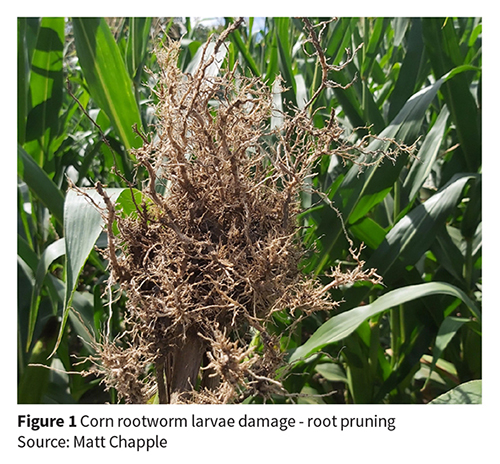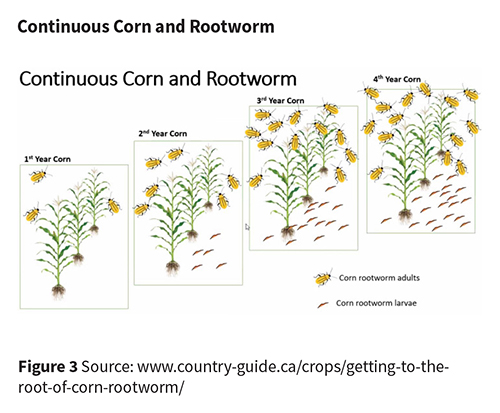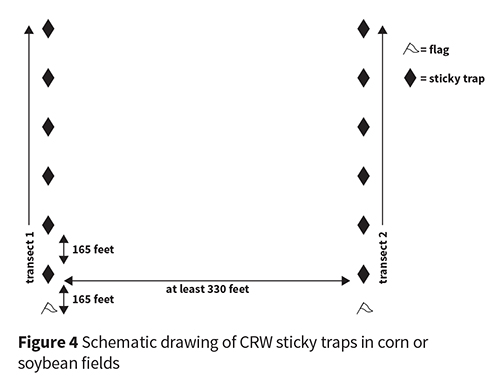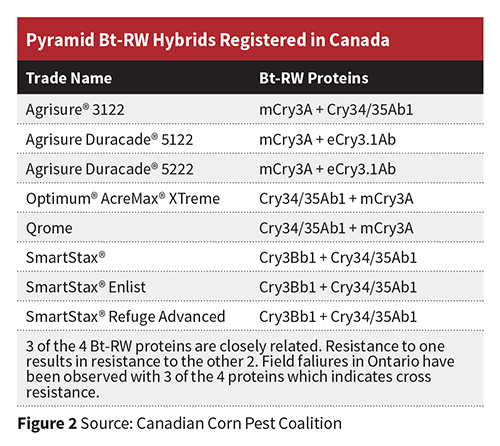Corn Rootworm Monitoring
 Corn Rootworm (CRW) is becoming a growing concern in continuous corn rotations due to the breakdown of many Bt corn traits. Bt resistant CRW has resulted in measurable yield loss and has triggered an urgent call for farmers to implement management strategies regarding the utilization of Bt proteins. Greater crop rotations are necessary to break the cycle of resistance development. Switching to a different Bt corn trait in the 2021 growing season is not considered an effective mitigation strategy as the pressure for resistance development is so strong.
Corn Rootworm (CRW) is becoming a growing concern in continuous corn rotations due to the breakdown of many Bt corn traits. Bt resistant CRW has resulted in measurable yield loss and has triggered an urgent call for farmers to implement management strategies regarding the utilization of Bt proteins. Greater crop rotations are necessary to break the cycle of resistance development. Switching to a different Bt corn trait in the 2021 growing season is not considered an effective mitigation strategy as the pressure for resistance development is so strong.
Integrated Pest Management Strategy
- Rotation will reduce CRW populations
- 2 years of rotation is important because not everyone will rotate in 2021, soybeans can provide site for egg-laying.
- Switching to a pyramid Bt-CRW traited product is discouraged, as these hybrids are now single trait hybrids at best
- If you cannot rotate – use a non-CRW Bt corn hybrid (+ root protection)
- Livestock Producers – consider land swap arrangements with non-corn growing neighbours, or consider alternative feed sources (alfalfa, wheat, sorghum)

CRW Scouting Efforts
Throughout Ontario and Quebec in 2020 growing season: sites were scouted for CRW adults starting from silking through to early dent. Sites focused on continuous corn acres and various soil textures. These sites were monitored on a weekly basis from 1 week pre silk to 4 weeks post pollination to early dent stage. Observations were noted on signs of root lodging and silk clipping in sites.
How does CRW scouting work?
- 4 CRW sticky traps are placed approx. 30 acres apart from each other on 1 transect and transect is needs to be set up 4 CRW sticky traps and on placed a minimum of 330 ft from the first apart. The first trap at least 165 feet in from the field edge.
- Pheromone traps were attached to the stalk directly above the developing ear.
- Traps were monitored weekly from silking through to early dent and average daily catch of Western and Northern Corn Rootworm numbers are recorded.
 In 2020 Growing season there were very low numbers observed on a weekly basis across all trap sites. The most commonly trapped Rootworm was Northern Corn Rootworm, with a low percentage of traps seeing a spike post pollination. Pest pressure was held relatively low with no sites meeting an action threshold and overall peak pressure was on average 3 weeks post pollination where no significant root clipping or ear feeding was correlated to yield loss. Trapping and screening will continue throughout 2021 in an effort to mitigate resistance development and develop farm specific management strategies around continuous corn production.
In 2020 Growing season there were very low numbers observed on a weekly basis across all trap sites. The most commonly trapped Rootworm was Northern Corn Rootworm, with a low percentage of traps seeing a spike post pollination. Pest pressure was held relatively low with no sites meeting an action threshold and overall peak pressure was on average 3 weeks post pollination where no significant root clipping or ear feeding was correlated to yield loss. Trapping and screening will continue throughout 2021 in an effort to mitigate resistance development and develop farm specific management strategies around continuous corn production.
Resources
- Canadian Corn Pest Coalition
- www.trece.com/corn-rootworm/
- www.fieldcropnews.com/2021/01/taking-root-management-options-for-bt-resistant-corn-rootworm-on-ontario-farms/
- Click here for the PDF of this project and the rest of the PRIDE Seeds 2020 Agronomy Projects.


